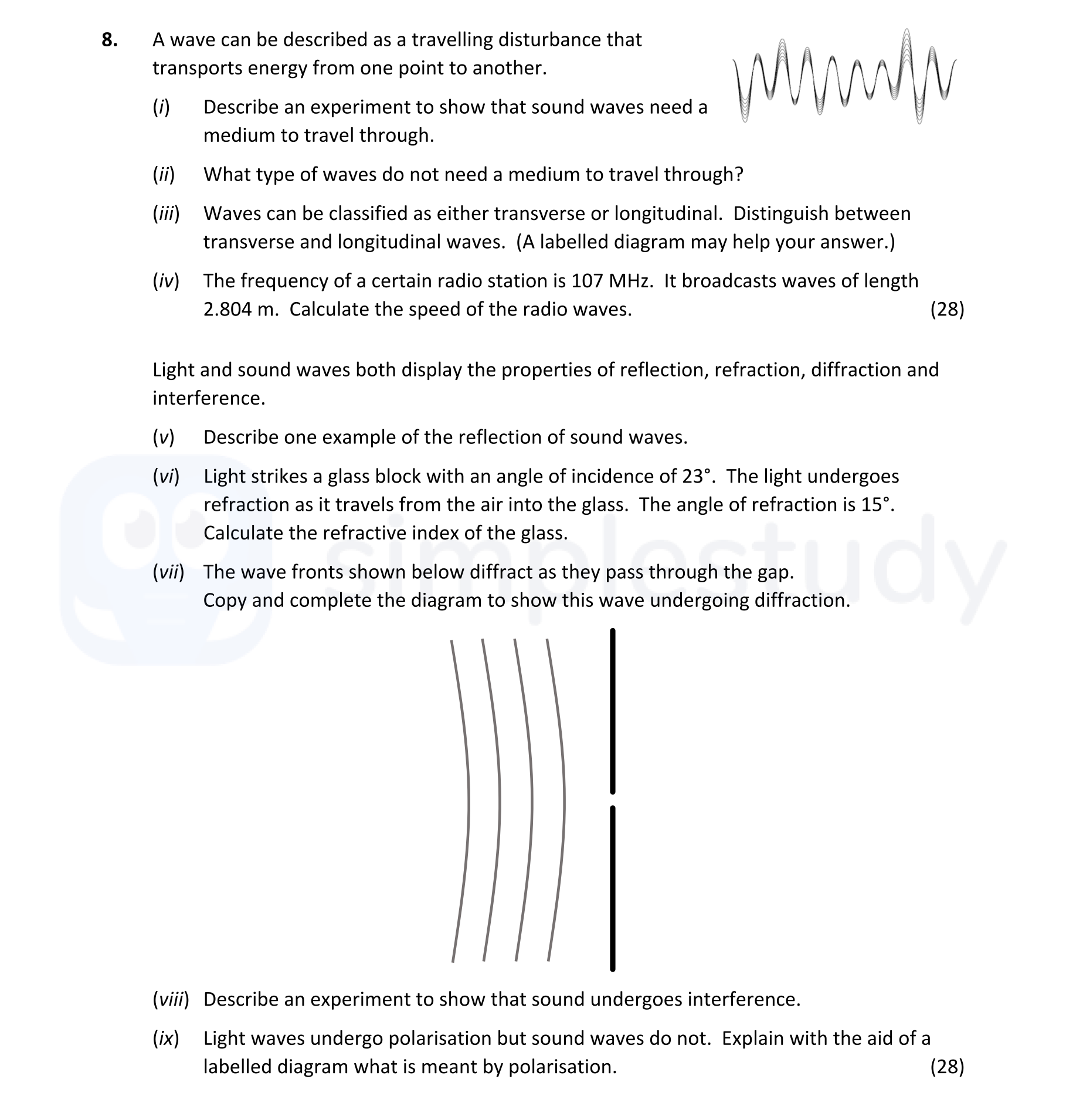Photo AI
A wave can be described as a travelling disturbance that transports energy from one point to another - Leaving Cert Physics - Question 8 - 2021
Question 8

A wave can be described as a travelling disturbance that transports energy from one point to another. (i) Describe an experiment to show that sound waves need a med... show full transcript
Worked Solution & Example Answer:A wave can be described as a travelling disturbance that transports energy from one point to another - Leaving Cert Physics - Question 8 - 2021
Step 1
Describe an experiment to show that sound waves need a medium to travel through.
Answer
One possible experiment involves using a bell jar apparatus. Start by placing a ringing electric bell inside the jar. Next, use a vacuum pump to remove air from the jar. As the air is evacuated, observe the sound produced by the bell. In air, the bell can be heard clearly, but as the air is removed, the sound diminishes until it cannot be heard at all. This demonstrates that sound needs a medium (in this case, air) to travel through.
Step 2
Step 3
Waves can be classified as either transverse or longitudinal. Distinguish between transverse and longitudinal waves.
Answer
Transverse waves are those where the disturbance is perpendicular to the direction of wave propagation. For example, in visual representations of waves on a string, the oscillation occurs up and down while the wave moves left to right. Longitudinal waves, on the other hand, have oscillations that are parallel to the direction of wave propagation. A common example is a sound wave, where air particles oscillate back and forth in the same direction as the wave travels.
Step 4
The frequency of a certain radio station is 107 MHz. It broadcasts waves of length 2.804 m. Calculate the speed of the radio waves.
Answer
To calculate the speed (v) of the radio waves, we can use the formula: where: f is the frequency (107 MHz = 107 x 10^6 Hz) and \lambda is the wavelength (2.804 m). Thus,
Step 5
Describe one example of the reflection of sound waves.
Answer
An example of the reflection of sound waves is an echo. When sound waves travel from a source to a distant surface (such as a wall or cliff) and bounce back to the listener, the sound produced is an echo. This phenomenon illustrates how sound can reflect off surfaces.
Step 6
Step 7
Copy and complete the diagram to show this wave undergoing diffraction.
Answer
To complete the diagram, illustrate the wave fronts spreading out as they pass through the gap. Draw lines representing the wave fronts on either side of the gap diverging from the gap to show the diffraction pattern.
Step 8
Describe an experiment to show that sound undergoes interference.
Answer
One method involves using two loudspeakers placed at a set distance apart. Connect them to the same audio source and ensure they are both emitting sound waves. As the waves from each speaker meet at certain points, they will interfere either constructively or destructively, depending on their phase relationship. Participants can then listen for variations in sound intensity at different positions in the room and note where louder or softer sounds occur, illustrating the principle of interference.
Step 9
Explain with the aid of a labelled diagram what is meant by polarisation.
Answer
Polarisation refers to the orientation of vibrations in a transverse wave to a single plane. Light waves can be polarised, which restricts their oscillations to a specific direction. In a labelled diagram, show how light vibrations are constrained to a plane, while sound waves, which are longitudinal, cannot be polarised in this manner and vibrate in multiple directions.
